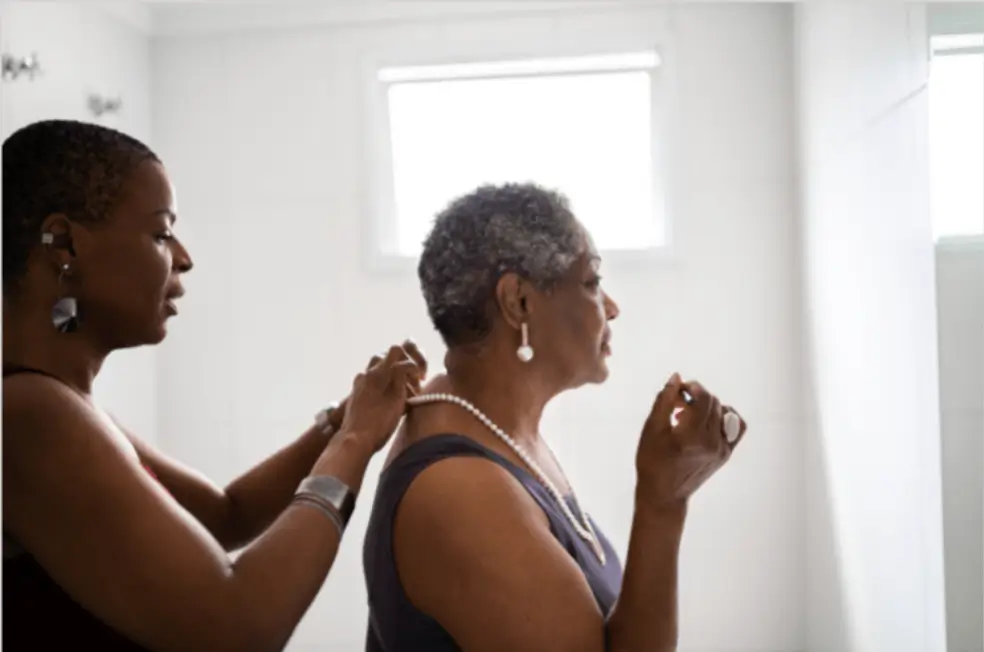Dressing Older Adults: Tips for Helping Seniors Get Dressed
Dressing Older Adults: Tips for Helping Seniors Get Dressed

The Importance of Dignified Dressing Assistance for Seniors
Dressing older adults requires patience, understanding, and the right approach to maintain their dignity while ensuring comfort and safety. As our loved ones age, physical changes such as arthritis, reduced mobility, or balance issues can make getting dressed challenging. However, with proper techniques and adaptive clothing solutions, caregivers can provide effective dressing assistance for seniors while preserving their independence and self-esteem.
Understanding how to help elderly parents get dressed involves more than simply putting on clothes—it’s about maintaining their sense of identity, personal style, and autonomy. Whether you’re a family member or professional caregiver, these elderly dressing tips will help you create a positive, stress-free experience for both you and your loved one.
Prioritize Personal Style and Preferences
One of the most crucial aspects of helping seniors get dressed is respecting their personal clothing preferences and established sense of style. Many caregivers make the mistake of choosing clothes based solely on convenience, but this approach can negatively impact a senior’s self-image and confidence.
When selecting clothing for older adults, consider their lifelong preferences. If your loved one has always preferred button-down shirts and tailored pants, don’t suddenly switch to sweatpants and t-shirts unless there’s a specific medical reason. Instead, look for ways to modify their preferred styles to make them more accessible.
Avoid imposing your personal style preferences on your loved one unless medically necessary. Remember that clothing choices are deeply personal and connected to one’s identity. By honoring their preferences while implementing practical modifications, you help maintain their dignity during the dressing routine for seniors.
Encourage Independence in Daily Dressing
A fundamental principle in dressing older adults is to allow them to dress themselves as much as possible before stepping in to assist. This approach serves multiple purposes: it maintains their sense of independence, provides gentle physical exercise, and reduces frustration that can arise from feeling helpless.
When implementing this strategy, be prepared that the process may take longer than if you did everything yourself. However, this extra time investment pays dividends in preserving your loved one’s self-esteem and motor skills. Start the dressing process earlier to accommodate this extended timeframe without creating stress or rushing.
Watch for signs that assistance is needed rather than automatically taking over. Many seniors can manage some aspects of dressing independently while needing help with specific tasks like fastening buttons or putting on compression stockings. This selective assistance approach is key to successful elderly dressing tips.
Choose Easy-to-Wear Clothing and Adaptive Solutions
Selecting appropriate clothing for older adults can dramatically improve their dressing experience and maintain independence longer. Adaptive clothing for seniors incorporates design elements that accommodate physical limitations while maintaining style and comfort.
Recommended Clothing Modifications
When choosing easy-to-wear clothes for elderly individuals, consider these practical modifications:
- Elastic waistbands: Replace traditional belt-fastened pants with elastic waistbands that eliminate the need for fine motor skills while providing comfort and ease of movement.
- Velcro fasteners: Substitute traditional buttons and zippers with Velcro closures, which are much easier for seniors with arthritis or limited dexterity to manage.
- Larger buttons and zipper tabs: If traditional fasteners are preferred, opt for clothing with oversized buttons or zipper pulls that are easier to grasp and manipulate.
- V-neck sweaters and cardigans: These styles are significantly easier to put on than crewneck sweaters, which require more arm flexibility and range of motion.
- Front-opening garments: Choose shirts, dresses, and jackets that open in the front rather than requiring overhead movement.
These clothing modifications for seniors maintain style while addressing practical needs, making the daily dressing routine more manageable and less stressful.
Simplify Decision-Making Process
Cognitive changes that sometimes accompany aging can make decision-making challenging. When learning how to dress an elderly person, it’s important to streamline choices without eliminating autonomy entirely.
Instead of asking open-ended questions like “What do you want to wear today?”—which can be overwhelming—offer limited, specific choices. For example, “Would you like to wear the blue shirt or the yellow shirt today?” This approach provides control while preventing decision paralysis.
This strategy also eliminates the possibility of choosing not to get dressed at all, which can happen when seniors feel overwhelmed by too many options. Laying out two or three appropriate outfit combinations the night before can further streamline morning routines and reduce stress for both caregiver and senior.
Proper Dressing Order and Technique
Understanding the correct sequence for dressing assistance for seniors can prevent injury and make the process more comfortable. These dressing tips for caregivers focus on accommodating physical limitations and reducing strain.
Step-by-Step Dressing Method
When putting on shirts, jackets, or other upper-body garments, always start with the weaker or more affected arm. This prevents putting excessive stress on the weaker limb when threading it through the second armhole. When removing these garments, reverse the process by starting with the stronger arm.
Specialized Techniques for Different Items
Compression stockings present unique challenges in senior-friendly clothing routines. Here’s an effective technique for putting them on:
- Put your hand inside the sock until you touch the toe area
- Turn half of the sock inside out
- Place the sock over your loved one’s toes
- Carefully slide the sock over the heel
- Gently pull the rest of the sock up the leg into position
Helpful Aids
Several tools can make dressing older adults easier:
- Rubber gloves: Provide better grip when handling compression stockings or smooth fabrics
- Compression stocking aids: Specialized devices that help position and pull up compression wear
- Button hooks: Assist with small buttons when fine motor skills are limited
- Zipper pulls: Extend zipper tabs for easier grasping
Apply compression stockings in the morning when swelling is typically minimal, and ensure legs are completely dry for easier application. These practical dressing tips for caregivers can significantly reduce the time and effort required for daily dressing routines.
Creating a Comfortable Dressing Environment
The environment where dressing older adults takes place greatly impacts the experience. Ensure the room is warm enough to prevent discomfort during clothing changes, and provide adequate lighting to help seniors see what they’re doing and feel more secure.
Consider installing grab bars near seating areas used for dressing, and ensure that chairs or beds used during the process are at appropriate heights. Having all necessary items within easy reach prevents interruptions and maintains the flow of the dressing routine.
Maintaining Dignity Throughout the Process
Remember that helping seniors get dressed involves more than physical assistance—it requires emotional sensitivity and respect for privacy. Always explain what you’re doing and ask permission before helping, even if cognitive function is impaired.
Preserve modesty by covering areas not currently being dressed, and work efficiently to minimize exposure time. Maintain a calm, patient demeanor even if the process takes longer than expected or becomes frustrating.
For more essential caregiving tips, visit here for tips on bathing (Essential Bathing Tips for Older Adults) for your loved ones.
This original article is courtesy of Active Daily Living.



